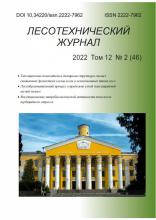Voronezh, Voronezh, Russian Federation
Under the influence of recreational impacts on plantings, their protective function, sustainability, aesthetics and natural appeal reduce. The objects of study are artificial pine plantations of 62 years of age, of different stages of digression (TLU-A2) on the sites of Somovskoe forestry of the Voronezh region. The paper explored the influence of recreational impacts on different components of forest phytocenosis. As it increases, the number of trees of the 1st category state ("no signs of weakening") significantly reduces and the number of trees 5-th and 6-th categories of the state ("fresh and old deadwood deadwood") increases. With the increase of anthropogenic influence the amount podletochnyh species, forest species of ground cover decreases and the number of weed and meadow species increases. Quickbeam (Sorbus aucuparia L) is the most resistant to recreational impact, volatile species are black alder (Frángula álnus, Mill) and wild pear tree (Pýrus commūnis, - L). With increasing stage of digression, the amount of trustworthy undergrowth of Scotch pine is reduced, the amount of questionable and unreliable undergrowth increases. The basis of natural regeneration in the forest plantations of Scots pine of 62 years of age is, in stage I of digression, single (46 %) and group (27 %) undergrowth of different age, located in the glade; its share is 49 % and 20 % respectively in stage II of digression; in stage III – single, medium, and large undergrowth (12%) in glades. Natural regeneration of tree species in trampled areas will not be able to ensure the restoration of forests and would require additional costs of afforestation in the future.
Scotch pine (Pinus sylvestris, L.), stability of plantations, stage of digression, condition category, components of biogeocenosis.
1. Vodolazhskiy A. N. Optimizatsiya rekreatsionnogo ispol'zovaniya borov zelenoy zony g. Voronezha Avtoref. dis. kand. s.-kh. nauk [To optimize recreational use of the hog in the green area of Voronezh Author. dis. kand. agricultural Sciences]. Voronezh. 2007, 22 p. (In Russian). EDN: https://elibrary.ru/NITGKX
2. Zhizhin N. P. K metodike izucheniya rekreatsionnoy digressii lesnykh biogeotsenozov [The methodology For the study of recreational digression of forest ecosystems]. Priroda i nauchno-tekhnicheskiy progress [Nature and technological progress]. Chisinau. 1973, pp. 164-166. (In Russian).
3. Kozin E. K. Chto nazyvat' podrostom [What is called regeneration]. Lesovedenie [Forestry]. 2011, no 1, pp. 69-72. (In Russian). EDN: https://elibrary.ru/NSYGVR
4. Melekho I. S. Lesovedenie [Dendrology] Moscow, 1980, 408 p. (In Russian).
5. Nakvasina E. N. Geograficheskaya izmenchivost' kak osnova semenovodstva sosny obyknovennoy na Evropeyskom Severe Rossii Avtoref. diss. dokt. s.-kh. nauk [Geographic variation as a basis of seed production of Scots pine in the European North of Russia diss. doctor. of agricultural Sciences]. Saint-Petersburg. 2000, 38 p. (In Russian).
6. Prokosheva K.Yu. Vliyanie rekreatsionnogo vozdeystviya na komponenty lesnogo fitotsenoza na territorii Udmurtii [Effect of recreational impact on components of forest phytocenosis on the territory of the Udmurt Republic] Lesnoy vestnik [Forest Bulletin]. 2009, no 3, pp. 25-33. (In Russian).
7. Tyrchenkova I. V. Struktura lesnykh kul'tur sosny obyknovennoy v nasazhdeniyakh razlichnykh stadiy digressii [Structure of forest cultures of a pine in stands of different stadiy digression] Problemy i perspektivy razvitiya lesomelioratsiy i lesnogo khozyaystva v Yuzhnom federal'nom okruge: mater. mezhdunar. nauch.- prakt. konf., posv. 90- letiyu vysshego lesnogo obrazovaniya na Donu [Problems and prospects of development of lamellibrachia and forestry in the southern Federal district]. Intern. scientific.- pract. Conf. dedicated. The 90th anniversary of higher forestry education on the don]. Novocherkassk. 2010, pp. 215-218. (In Russian).
8. Ushatin I.P. Uchebnaya praktika po lesovodstvu metodicheskie ukazaniya dlya studentov spets. 31.12 - «Lesnoe i sadovo-parkovoe khozyaystvo» [Teaching practice of forestry methodical instructions for students special. 31.12 - "Forestry and garden-Park economy"] «Voronezhskiy ordena druzhby narodov lesotekhnicheskiy institut" ["Voronezh order of peoples ' friendship Institute of forestry"]. Voronezh. 1991, 70 p. (In Russian).
9. Debort S., Meyer D. Degradation de lecosysteme forestier: analyse et ebauchen de solutions. Schweiz. Z. Forstw. 1989, Vol. 11, pp. 965-976.
10. James T.D., Smith D.W., Mackintosh E.E. Effects of camping recreation on soil, jacke pine and understor vegetation in a northwestern Ontario park. Forest Sci. 1979, Pt. 25, Vol. 2, pp. 333-349.
11. J. F. Franklin Structural and functional diversity in temperate forests. Biodiversity. Washington : Nat. Acad. Press, 1988, pp. 166-175.












